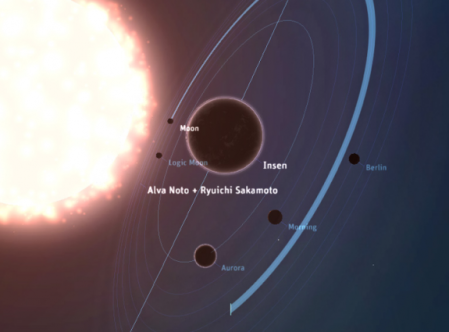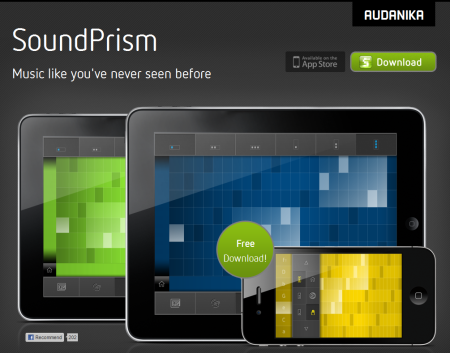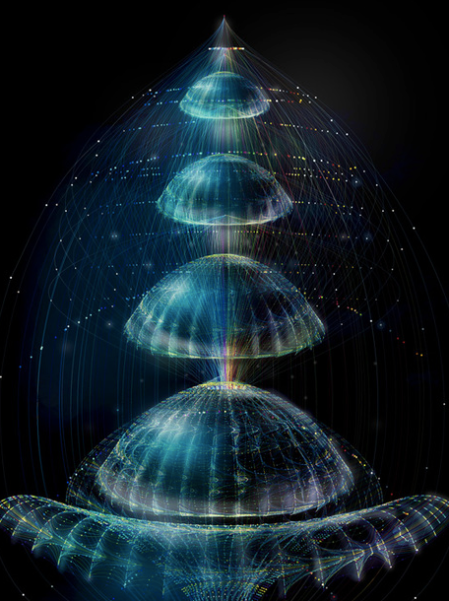Musical Solar System
April 29, 2011A new iPad app called Planetary, which drops on May 2, visualizes your entire music collection as a solar system: artists are stars, albums are planets, and tracks are moons. (a big thanks to FlowingData for the heads up here!) I wouldn’t be surprised if the idea came from Kepler’s idea of a music universalis, though this celestial take on music has never been expressed quite as literally before.
It’s sure to be a fun, immersive take on what has traditionally been a pretty unremarkable task: browsing your music. As with my recent posts about SoundPrism and iRig, the iPhone and iPad are starting to inspire musicians and developers to dream up completely new ways of visualizing and creating music. Traditional frameworks and systems (like the keyboard) are being questioned as new interfaces (like touchscreens) redefine what’s possible.
We’ll have to see if Planetary is actually a “better” way to explore music, but in the meantime I’ll definitely take “more stunning.”
Check out the official website: http://planetary.bloom.io/
SoundPrism
April 7, 2011“Music like you’ve never seen before.”
SoundPrism is a brand new app that completely reimagines musical notation and how sound is visualized. The imagination required to do this is impressive, but it’s the nuanced execution and beautiful design that make it noteworthy.
At its core, SoundPrism is simply a music sequencer that is beautiful and easy to use. But that completely undersells what’s going on here and the level of consideration that went into its creation. To get a feel for what this app is all about, check out this introductory video:
Here are three key takeaways I want to point out:
“SoundPrism is based on the theory that music is interesting if you create tension and release it.”
This quote from the clip is absolutely true, and the foundation of all Western music theory. Music is a beautiful, elaborate departure from the “home” note (the tonic of whatever key you’re in) through various cadences and chord progressions that lead to the chord furthest away from home: the dominant, or V chord, thus creating a faint sense of unease (which I think we’ve all felt when we’re away from home…). The journey back to the tonic note leads to a sigh of relief as the tension is released. Everyone from Chuck Berry to Bach created music with this principle in mind, if only subconsciously. Ever hear of 3-chord rock? The three chords are the I, IV, and V of a key. The progression from I to V and back again is part of the propulsive force that makes the music so dynamic and exciting (along with the rhythm, of course). So while Beethoven’s journey through the 5th Symphony is undeniably epic and complex, blues is simply a distillation of the same tension-and-release principle, boiled down to the most essential chords while keeping the music interesting.
What makes SoundPrism so great is that its creators made a point not just to make the app easy to use, but to make the manipulation of tension and release easy to control. Why? Because it’s an essential part of making interesting pieces of music. It’s a fact that, to my knowledge, has never before been acknowledged by creators of musical software.
You don’t change keys, you change colors.
It’s a synaesthetic‘s dream. When you scroll up on the interface the hue shifts like the Northern Lights. There is no mention of being in F-sharp or B-flat, but rather in “green” or “purple.” I don’t think it’s a coincidence that the word “tone” is used by both visual artists and musicians to refer to roughly the same concept.
Major and minor modalities are treated independent of key.
Usually one will refer to the mode and the key at the same time. For example, “This song is in D major,” or, “We’ll be transposing this piece into G-minor.” But in SoundPrism you interact with modes in the same way you interact with notes, which is a massively different way of conceptualizing music-making. The odd-numbered horizontal lines are slightly brighter, and gestures along those lines will result in notes in the major mode. The even-numbered horizontal lines are slightly darker and correspond to the minor mode. The SoundPrism creators refer to these modes as “happy” and “sad” respectively, which isn’t a new comparison (this is how most musicians first learn the difference) but somehow seems more appropriate here.
This app, especially in its Pro version with upcoming Core MIDI support, shows a lot of promise for film scoring, demo production, and ambient soundscape creation. But what may be more exciting is what it could bring to the non-musician community, as it strips away some of the layers of technical skill and knowledge required to compose music in the first place.
The future definitely looks bright… and colorful.
Music Is Math
December 19, 2010Big thanks to the Behance Network for turning me on to the amazing work of Tatiana Plakhova, whose series “Music Is Math” is a meditation on the mathematical nature of sound, expressed in exciting and complex visualizations. Her work is grounded in exploring patterns and repeated forms, but she does so with a celestial eye and encourages us to consider tiny aspects of reality as being microcosms unto themselves.
The image above could fit equally as well in a NASA photo gallery as it could in a physicist’s treatise on string theory, yet it was inspired by music. Mathematical patterns and recursive vertices weave in and out of all three topics, but it took an artist as talented as Tatiana to bring the similarities into bright focus.
You can order prints and wallpapers at Complexity Graphics: http://www.complexitygraphics.com/
Music Philosophy: Lyrics as Graphics
September 8, 2010While neither philosophical nor particularly musical, the designer Mico has applied his graphic design prowess to music quotes. Enjoy. “Music Philosophy”
(You can also snag poster versions of your favorite quotes over at Etsy)
Related post: “Music philosophy,” combining music and graphics“
A Master Class in Songwriting
June 18, 2010This is brilliant. Paul Simon sits down with Dick Cavett to discuss music, and he uses his then-unfinished song, “Still Crazy After All These Years,” to demonstrate his take on songwriting and music theory. His bridge begins with a D9 chord, which he introduces for the sole purpose of introducing C and C-sharp—two notes that haven’t been used in the song yet. He even gives a great breakdown of a guitar’s standard tuning and the fact that all of those open strings actually do form a legitimate chord… two actually: E minor 7th and G6: Both chords are identical in the notes they include.
Aside from the sad fact that you would never see this type of discussion on a talk show these days, I find remarkable the topics that get introduced along the way:
“It’s one of those lines that has the right inflection… it swings.” – Paul Simon drops this offhanded remark after Dick Cavett playfully interjects, “Have you ever reached for your C-sharp and gotten your C-natural?” Paul picks up on the cadence and rhythm of Cavett’s sentence, not its meaning.
“You’re Theatre People. Theatre People come at music from another direction.” – Paul notes that your relationship with music affects your knowledge of it. Paul, being a musical architect of sorts, knows the engineering of it, naming chords and resolving cadences. Cavett, ever the entertainer, adores music (enough to have a conversation like this on television) but through a different lens. It’s an astute observation by Paul: music means different things to different people.
“I imagine the same principle would hold true in comedy…” – Comedy?! Yes. Right in line with his comments about the timing and inflection of Cavett’s “joke,” Paul compares music theory to comedy, and rightfully so. Timing, delivery, freshness, variety… all adjectives at home in both worlds.
The point here is that a topic like music invariably opens up conversation into the rest of the humanities. I truly believe that the arts are somehow linked on a primal, atavistic level and that all artists are using the same creative fuel.
Kandinsky on Art
April 26, 2010JFK on Art
December 17, 2009Too often in the past we have thought of the artist as an idler and dilettante, and of the lover of arts as somehow sissy or effete. We have done both an injustice. The life of the artist is, in relation to his work, stern and lonely. He has labored hard, often among deprivation, to perfect his skill. He has turned aside from quick success in order to strip his vision of everything secondary or cheapening. His working life is marked by intense application and intense discipline. As for the lover of arts, it is he who, by subjecting himself to the sometimes disturbing experience of art, sustains the artist — and seeks only the reward that his life will, in consequence, be the more fully lived. — JFK, 1962
I nicked this quote from an article in the January 2009 issue of Esquire Magazine: The Kennedys: What I’ve Learned
Wisdom Bits
December 15, 2009Take a minute to check out Wisdom Bits. It’s a neat little diversion of a site that simply, and stylishly, reveals wisdom through pop music. Just hover over an artist’s colored square to reveal the nugget of truth inside…
Dreams as Art as Business
October 4, 2009“Everyone must begin to trust their dreams because out of that trust is born the artist, and the artist is the role model for the entrepreneur we now need.”
– Ernest Hall (entrepreneur and musician) from The Creative Economy: How People Make Money From Ideas



 Posted by Mark
Posted by Mark 









